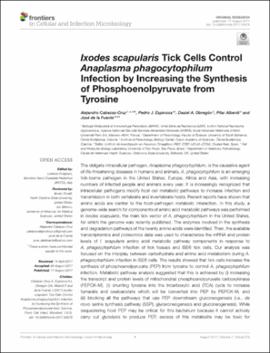| dc.contributor.author | Cabezas-Cruz, Alejandro | |
| dc.contributor.author | Espinosa, Pedro J. | |
| dc.contributor.author | Obregon, Dasiel A. | |
| dc.contributor.author | Alberdi, Pilar | |
| dc.contributor.author | de la Fuente, Jose | |
| dc.date.accessioned | 2019-08-28T16:00:58Z | |
| dc.date.available | 2019-08-28T16:00:58Z | |
| dc.date.issued | 2017-08-17 | |
| dc.identifier | oksd_cabezascruz_ixodesscapulari_2017 | |
| dc.identifier.citation | Cabezas-Cruz, A., Espinosa, P. J., Obregon, D. A., Alberdi, P., & de la Fuente, J. (2017). Ixodes scapularis tick cells control Anaplasma phagocytophilum infection by increasing the synthesis of phosphoenolpyruvate from tyrosine. Frontiers in Cellular and Infection Microbiology, 7, Article 375. https://doi.org/10.3389/fcimb.2017.00375 | |
| dc.identifier.uri | https://hdl.handle.net/11244/321395 | |
| dc.description.abstract | The obligate intracellular pathogen, Anaplasma phagocytophilum, is the causative agent of life-threatening diseases in humans and animals. A. phagocytophilum is an emerging tick-borne pathogen in the United States, Europe, Africa and Asia, with increasing numbers of infected people and animals every year. It is increasingly recognized that intracellular pathogens modify host cell metabolic pathways to increase infection and transmission in both vertebrate and invertebrate hosts. Recent reports have shown that amino acids are central to the host-pathogen metabolic interaction. In this study, a genome-wide search for components of amino acid metabolic pathways was performed in Ixodes scapularis, the main tick vector of A. phagocytophilum in the United States, for which the genome was recently published. The enzymes involved in the synthesis and degradation pathways of the twenty amino acids were identified. Then, the available transcriptomics and proteomics data was used to characterize the mRNA and protein levels of I. scapularis amino acid metabolic pathway components in response to A. phagocytophilum infection of tick tissues and ISE6 tick cells. Our analysis was focused on the interplay between carbohydrate and amino acid metabolism during A. phagocytophilum infection in ISE6 cells. The results showed that tick cells increase the synthesis of phosphoenolpyruvate (PEP) from tyrosine to control A. phagocytophilum infection. Metabolic pathway analysis suggested that this is achieved by (i) increasing the transcript and protein levels of mitochondrial phosphoenolpyruvate carboxykinase (PEPCK-M), (ii) shunting tyrosine into the tricarboxylic acid (TCA) cycle to increase fumarate and oxaloacetate which will be converted into PEP by PEPCK-M, and (iii) blocking all the pathways that use PEP downstream gluconeogenesis (i.e., de novo serine synthesis pathway (SSP), glyceroneogenesis and gluconeogenesis). While sequestering host PEP may be critical for this bacterium because it cannot actively carry out glycolysis to produce PEP, excess of this metabolite may be toxic for A. phagocytophilum. The present work provides a more comprehensive view of the major amino acid metabolic pathways involved in the response to pathogen infection in ticks, and provides the basis for further studies to develop novel strategies for the control of granulocytic anaplasmosis. | |
| dc.format | application/pdf | |
| dc.language | en_US | |
| dc.publisher | Frontiers Media | |
| dc.rights | This material has been previously published. In the Oklahoma State University Library's institutional repository this version is made available through the open access principles and the terms of agreement/consent between the author(s) and the publisher. The permission policy on the use, reproduction or distribution of the material falls under fair use for educational, scholarship, and research purposes. Contact Digital Resources and Discovery Services at lib-dls@okstate.edu or 405-744-9161 for further information. | |
| dc.title | Ixodes scapularis tick cells control Anaplasma phagocytophilum infection by increasing the synthesis of phosphoenolpyruvate from tyrosine | |
| osu.filename | oksd_cabezascruz_ixodesscapulari_2017.pdf | |
| dc.description.peerreview | Peer reviewed | |
| dc.identifier.doi | 10.3389/fcimb.2017.00375 | |
| dc.description.department | Veterinary Pathobiology | |
| dc.type.genre | Article | |
| dc.type.material | Text | |
| dc.subject.keywords | proteomics | |
| dc.subject.keywords | transcription | |
| dc.subject.keywords | phosphoenolpyruvate | |
| dc.subject.keywords | glycerol-3-phosphate | |
| dc.subject.keywords | ixodes scapularis | |
| dc.subject.keywords | anaplasma phagocytophilum | |
